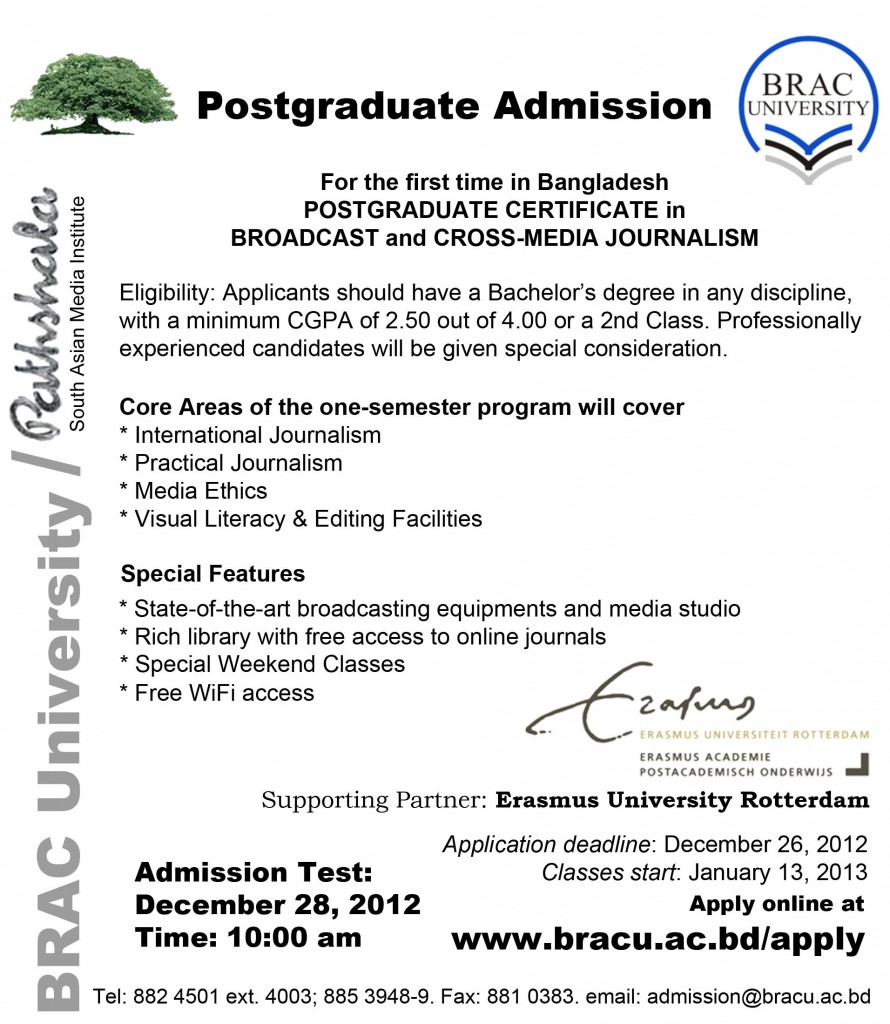?
?Basic Certificate course in Broadcast and Cross-Media Journalism
?Offered by
and
Pathshala South Asian Media Institute
?
Campus address:
TK Bhaban (12th floor), 13 Kawran Bazar
Dhaka 1215
Brief Overview:
- Introduction
The Certificate course in Broadcast and Cross-media Journalism is designed as a course of studies that will provide an academic and practical training to both practicing and potential journalists. The media industry in Bangladesh is witnessing an exponential growth and therefore there is a great need for trained and talented people. These new opportunities are also attracting a lot of young people into the profession. It is with these considerations in mind that BRACU and Pathshala South Asian Media Institure are offering this certificate course in broadcast and cross-media journalism.
The media industry worldwide is changing rapidly due to the technological innovations. In order to meet the new demands of the industry, practicing media personnel need more intense and continued training. This course will meet some of that demand.
1.1 Objectives
The certificate course will be a first step in our effort to cater to a growing need of training of personnel for the burgeoning culture industry. By partnering with Pathshala and Erasmus University based in Rotterdam Netherlands we will tap into the best minds to pursue such an objective.
The course is designed to impart theoretical critical understanding of new media trends, as well as to provide practical training. It will follow a class-room, as well as studio and site-based pedagogical approach.
1.2?For whom
The certificate course will cater to both practicing and potential journalists of all media. Practising journalists would greatly benefit for this certificate course.
1.3? Admission criteria
Prospective students must have an approved Bachelors degree in any subject, with a minimum CGPA of 2.5 out of 4.00 or a 2nd Class. In some exceptional cases, such as an experienced journalist or media person, this rule may be relaxed.?
- 2.??? Curriculum
2.1? Structure
A total of 12 credits would be required for the completion of the certificate course. 4 courses, each of 3 credits, will be offered. The following is a list of courses.?
Classroom hours will be 3 hours per week per 3-credit course for 13 weeks. An extra examination week will also be counted. Students are required to do another 3 hours of project work a week for each course.?
2.2? List of courses.
International Journalism (3 credits).
The course will provide an overview of the role of journalism, including its political and social context. The course will use micro, macro, historical, social and cultural lens to elucidate its contents.
Media Ethics (3 credits).
The course will concentrate on issues relating to freedom of speech and the freedom of the press. The newly-passed right to information act (RTI), will be examined in detail. Issues of fairness, values and codes will also be discussed, and? important component of the course will comprise issues of diversity, the nature of media portrayal, and issues of gender.
Visual Literacy (3 credits)
This course will introduce students to the grammar for film and television, as well as include a practical aspect on editing for film and television. Training in? semiotic analysis will help students understand the meaning of images and stories.
Practical Journalism (3 credits).
Starting with news production, this course will take students through the process of ?recognizing news, how news? value is created and news selection. Students will be encouraged to develop personal style leading to a sense of authorship. The course will give special attention to writing skills, including writing structure, the writing process, attractive writing, both for print media and internet, hooking, blogging and copy-editing.
2.3 Teaching Methods
The pedagogy will comprise of both classroom teaching and hands-on exercises. Each course is accompanied by a project that students will be evaluated on. Students will be exposed to a variety of media and journalistic approaches and technology, including internet, blogging, film and television, as well as editing for each medium. The course will be following a student-centred learning with interactive sessions, seminars and student presentations.?
2.4? Evaluation and grading
Students will be graded on examinations and projects. Special attention will be given to creativity, critical thinking and acquired skills. The grading will follow BRAC University grading system as approved by the UGC.
At the end of the course students will receive a certificate along with obtained grades from BRAC University and Pathshala South Asian Media Academy. These grades will be transferable, subject to university rules, to the MA in Broadcast and Cross Media Journalism.

